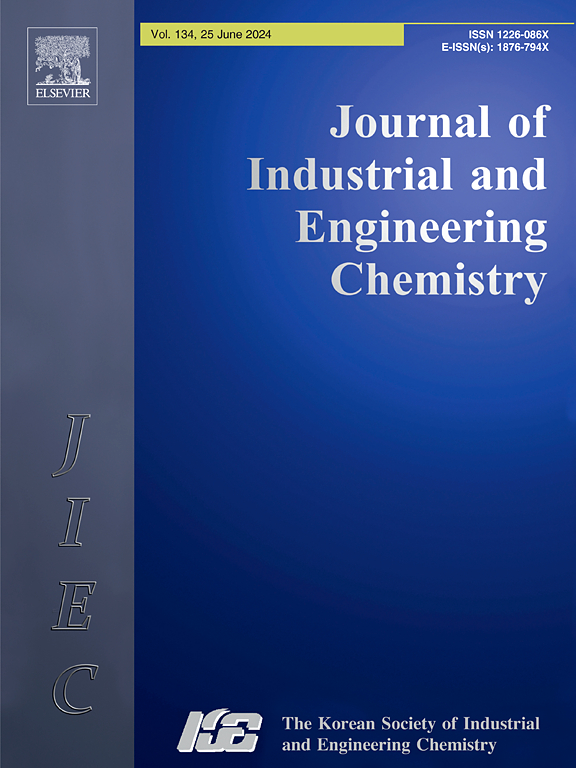氧化锡量子点修饰gC3N4纳米管的电化学性能:实验和理论见解
IF 5.9
3区 工程技术
Q1 CHEMISTRY, MULTIDISCIPLINARY
Journal of Industrial and Engineering Chemistry
Pub Date : 2025-04-30
DOI:10.1016/j.jiec.2025.04.043
引用次数: 0
摘要
我们提出了一种开创性的方法,将氧化锡量子点(SnQds)与石墨氮化碳纳米管(gCN)集成,形成一种新型电极材料gCN- snqd。对比评估显示,gCN-SnQd电极在三电极结构中表现出明显优越的电化学属性,超过了原始的gCN和SnQd电极。值得注意的是,gCN-SnQd电极具有稳定的比电容为640.19 F·g−1,放电时间为230.4 s。该材料表现出显著的容量保持能力,即使在10 a·g−1的显著电流密度下,也超过100%,在5000次充放电循环后保持稳定性。此外,在对称超级电容器器件中使用gCN-SnQd电极显示出27.72 Wh·kg−1的能量密度和1050 W·kg−1的功率密度。利用密度泛函理论(DFT)计算,我们细致地解释了SnQd集成后gCN纳米管电子性能的增强。本研究的经验见解提供了对gCN-SnQd在增加超级电容器的能量和功率密度方面所表现出的潜力的深入理解,从而推进了环保储能技术的领域。这项研究强调了精确工程纳米材料和最先进的计算方法在塑造电极材料设计景观方面的关键作用,这些材料表现出卓越和独特的性能概况。本文章由计算机程序翻译,如有差异,请以英文原文为准。

Electrochemical properties of tin oxide quantum dot decorated gC3N4 nanotubes: experimental and theoretical insights
We present a pioneering approach that employs tin oxide quantum dots (SnQds) integrated with graphitic carbon nitride nanotubes (gCN) to form a novel electrode material gCN-SnQd. Comparative assessments revealed that gCN-SnQd electrodes exhibited notably superior electrochemical attributes within a three-electrode configuration, surpassing their pristine gCN and SnQd counterparts. Significantly, the gCN-SnQd electrode exhibits an unwavering specific capacitance of 640.19 F·g−1 with incredible discharge time of 230.4 s. The material demonstrated remarkable capacity retention, surpassing 100 %, even at a significant current density of 10 A·g−1, maintaining stability after 5000 charge/discharge cycles. Furthermore, the utilization of gCN-SnQd electrodes in a symmetric supercapacitor device showcases promising energy density of 27.72 Wh·kg−1 and power density of 1050 W·kg−1. Employing density functional theory (DFT) calculations, we meticulously explained the enhancement in the electronic properties of gCN nanotubes upon the integration of SnQd. The empirical insights of this study offer an in-depth understanding of the potential exhibited by gCN-SnQd in augmenting the energy and power densities of supercapacitors, thereby advancing the realm of environmentally conscious energy storage technologies. This study emphasizes the pivotal role of precisely engineered nanomaterials and state-of-the-art computational methodologies in shaping the design landscape of electrode materials that exhibit exceptional and distinctive performance profiles.
求助全文
通过发布文献求助,成功后即可免费获取论文全文。
去求助
来源期刊
CiteScore
10.40
自引率
6.60%
发文量
639
审稿时长
29 days
期刊介绍:
Journal of Industrial and Engineering Chemistry is published monthly in English by the Korean Society of Industrial and Engineering Chemistry. JIEC brings together multidisciplinary interests in one journal and is to disseminate information on all aspects of research and development in industrial and engineering chemistry. Contributions in the form of research articles, short communications, notes and reviews are considered for publication. The editors welcome original contributions that have not been and are not to be published elsewhere. Instruction to authors and a manuscript submissions form are printed at the end of each issue. Bulk reprints of individual articles can be ordered. This publication is partially supported by Korea Research Foundation and the Korean Federation of Science and Technology Societies.

 求助内容:
求助内容: 应助结果提醒方式:
应助结果提醒方式:


